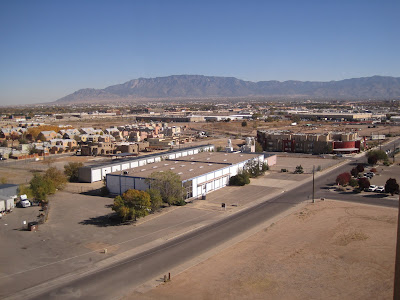







Joop and I went to New Mexico and Joop bought a fender for his car and I bought a Navajo headdress. It sounds weird but that is what it amounts to.
The New Mexican landscape it exceptionally beautiful. In the northeast section where we were, the land is a series of open plateaus interspersed with occasional mountains and land formations that look more like badlands. There is the sense of open vistas like the prairie where the sky is all but at the same time in every view there is sometype of geographic relief that adds incredible interest. So it is always about the play of light on the land and the many subtle colours. The vegetation is quite consistent at the various altitudes mostly scrub junipers and pinyon bushes, not much grass which could explain how even though it seems as though you are driving through miles and miles of ranchlands, and it is all fenced with barb wire as though intending to keep something in or out , there is not a cow or horse visible. People dress the part though and stopping in a tavern in an old ghost town called Madrid (has subsequently been taken over by squatters who set up galleries) the clientele are weathered old ranchers with hats and boots and neckscarves as though they just dismounted.
Driving through the landscape there is vast emptiness with the occasional fenced pueblo, which I took to be sometimes like a town on a reservation because they are quite vigilant about their privacy and often don’t encourage visitors. The dwellings in these pueblos are definitely adobe or pseudo- adobe, all meant to look the same and as part of the earth. There are also many, many casinos. I have decided that the native population that is not making pottery, jewelry, weavings or drums is running the casinos.
The only other visible industry is galleries. There is such a plethora of galleries in Santa Fe that it is enough to paralyse you.
Of the three towns that we visited I would say that Santa Fe is the place to make your base. Aside from too many galleries, too many shops, it is a nice little town to walk around. Our bed and breakfast was within two blocks of the downtown core and plaza. We walked everywhere. It was very pleasant. The food we ate was very good. We ate at 2 especially nice restaurants – an Italian and a bistro. With the food so good and accessible it was almost easy to overlook the paralysis that overcomes you when faced with too many goods to buy. I was so inundated with jewelry, pottery, weavings that I was completely unable to purchase. That has never happened to me before. The handful of goods that I did admire were all over $1000.00. I tried and tried to find something to purchase from the natives that sell their wares directly by sitting in front of the governors place which is like a long porch that is along one side of the plaza, but even then things were too overwhelming. A belt buckle I liked was $500.
So in the end the only items I ended up purchasing were at the hotel shop in Albuquerque. I even had to exclaim to the shop attendant that I had looked everywhere and only liked the things in his shop.
We went to the Georgia O’Keefe gallery in Santa Fe and really enjoyed the movies and collection. To visit her house in the town of Abiquiu you must book one month in advance. I would have liked to have seen it, just to see what aspect of the landscape consumed her so.
Last night we had guacamole made at our table. It was very entertaining, cheap and tastey, someone should take it up at home.
The one thing I will miss is my New Mexican hair - sleek and flat with no humidity.
















